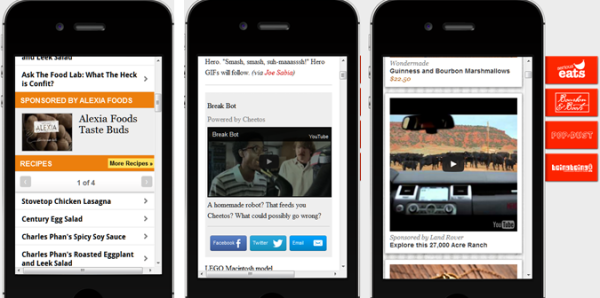
Native video ads for mobile could be the biggest content marketing trend of 2015. Photo credit: TNW
Native advertising has emerged in the past year as an effective and successful, albeit expensive, marketing channel in print publications and in online news sources. Native advertising is editorial content containing product messages. The sponsor pays the publication for placement. It’s also called sponsored content.
Next up: native advertising marries video marketing in native video ads — the next new thing in marketing. Social media platforms including Facebook and Twitter have adopted native video advertising. That represents a huge new opportunity for content marketers to distinguish themselves.
Over the past year, Facebook has added auto-play, view counts, and better mobile functions to their native video player. It’s also acquiring QuickFire Networks, a move it hopes will improve video quality while offering low bandwidth cost. With its enhanced video player, Facebook may be able to muscle out YouTube as the leading online video platform.
Twitter, for its part, is preparing to launch its own native player that will feature auto-play and customizable features.
Stephanie Losee, managing editor at Dell, which has run native ads on websites like The New York Times and Forbes, said she’s looking forward to running native video campaigns. “There is so much fun stuff happening in video, but we haven’t done much work in native video,” she told emarketer.
Native Video Tips for Marketers
Native video ads combined with mobile will revolutionize content marketing, predicts Chase McMichael, CEO of InfiniGraph, in an article for Search Engine Journal. McMichael offers these tips to marketers.
Go long. Longer-form video is desirable. Consumers are increasingly willing to watch longer videos as the industry moves beyond 20-second clips. Videos over 20 minutes increased 86 percent year over year, according to FreeWheel.
Hook ‘em with entertainment and information. Unlike the in-your-face broadcast infomercials, the talking heads approach doesn’t work in native video advertising. The most effective and successful native ads are wrapped in an inviting package of information and entertainment with low-key product messages.
Target mobile. Consider a mobile first strategy. Mobile users are more likely to interact with video than desktop users (though not necessarily the long-form varieties). In a case study for Disney Planes, mobile native video produced 70 percent higher click-through rate than the desktop’s 26 percent rate. Mobile activity has steadily increased over the last four years due to apps and more responsive web content.
Measure through engagement. Don’t assume that the number of people playing your videos is the best measurement the videos’ effectiveness. Evidence shows that the ratio of shares per post is a better way to measure native video ad success than plays or likes. Other than clicks to purchase, shares and comments are the best indications of videos’ effectiveness. Consumers who are willing to stamp their name on something with greater emotion tend to share or comment.
Dig the data. What consumers watch and share produces a gold mine of data. Companies that can dig into that data will gain worthwhile marketing insights and competitive advantage.
Budget big. Spending for mobile advertising is rising quickly as the quality and complexity of storytelling increases. Mobile ads will likely command television-sized budgets in the not too distant future. Brands that invest in mobile-ready solutions now will gain the competitive edge afforded early adopters.
Customize to devices. Marketers who customize native ads for each device will achieve the best results. A study by Innovid indicates that optimized ads can prompt a six fold increase in engagement rates, a seven fold increase in click-throughs, and a 25 percent rise in completion rates.
Nail down a good thumbnail. The thumbnail image piques consumer interest. Studies show that optimizing the thumbnail image can increase click-through rates from 5 to 30 percent.
Limit the promotions. Like text-based native ads, native video ads should not be too promotional, Losee advises. Audiences don’t mind if you mention your brand or tell a story that involves your brand. Stories can be funny, enlightening, silly or deep. Sponsored content works best when it matches the look, feel, and area of interest of the publication where the ad appears.
One caution: Follow regulatory guidelines on disclosures for native advertising.
Bottom Line: Native video ads, particularly for mobile devices, may be the major content marketing trend of 2015. Brands that produce videos that prompt consumer engagement will gain a competitive edge.
William J. Comcowich founded and served as CEO of CyberAlert LLC, the predecessor of Glean.info. He is currently serving as Interim CEO and member of the Board of Directors. Glean.info provides customized media monitoring, media measurement and analytics solutions across all types of traditional and social media.





Trackbacks/Pingbacks